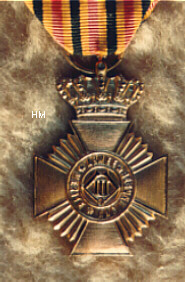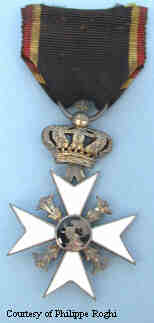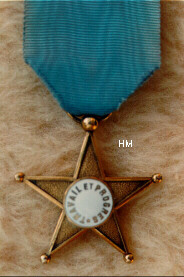Various types of this medal exist according to the sovereign at the time
of award. Originally instituted on 4 November 1892 by King Leopold II, in his capacity as
Sovereign of the Independent State of Congo, this medal was awarded for good and loyal
services by native Congolese to the Congo state. Recipients could be military, members of
the "Force Publique" or civilians.
Depicted is the medal as awarded during the reign of King Leopold III (in
use between 1937 and 1953) and suspended from a cornblue ribbon, indicating a military
award. A clasp with three stars indicates a total of 9 years of service (3 years per
star). The reverse inscription reads "Loyauté et Devouement" (Loyalty and
Dedication).
Also shown is the civilian variation of the medal, as awarded during the
reign of King Baudouin I. Civilian medals are identical to the military except for their
mainly yellow ribbon.
-
- Royal Houshold Decorations
-
Although affiliated to the awards of Belgium, these
decorations are bestowed privately and exclusively by the reigning Sovereign. The first
Belgian king to do so was Leopold II who instituted, on 21 July 1889, three separate
medals in two or three classes :
The Medal for Members of the Royal Household and
Members of the Households of the Royal Family, in three classes (silver gilt,
silver and bronze), for resp. 15, 25 and 35 years of loyal services.

The Medal for servants of Foreign Courts or
Foreign Heads of State, in three classes (silver gilt, silver, bronze), for
services rendered during official visits.
The Special Medal for Members of the Royal
Household and Members of the Households of the Royal Family, in two classes
(silver gilt and silver), for special meritorious acts.
|
-
- The Special Decorations
Instituted on 2 August 1889 and similar to the previous
decoration, this medal was awarded, either in Gold or Silver to managers, promoters and
persons having performed distinguished service to a number of organisations such as Health
Security, Cooperative Societies, Trade Unions, Social Security and Agricultural Societies.
|
 |
 |
 |
| Health Security model |
Trade Union model |
Agricultural Society model |
-
- Medal of the Arab Campaign
Doubtlessly the most attractive and important colonial campaign medal
created in Belgium, this dark bronze medal was awarded to members of the "Force
Publique", Belgium's colonial armed force in the Congo, in commemoration of the
operations to expel Arab slave traders from the territory in a hard-fought campaign that
lasted between 1892 and 1894.
|
-
- Commemorative Decoration of the 50th Anniversary
of the Ostend-Dover Line
Two crosses, one in gilt silver and white enamel, the other in silver
only, were created on 27 February 1896 for resp. employees and workmen of the Ostend-Dover
Line with a minimum of 25 years of good and loyal service.
|
-
- Commemorative Decoration of the 50th Anniversary
of the Telegraphic Services
As with the previous decoration, 25 years of good and loyal service by
employees and workmen of the Belgian telegraphic services were rewarded by two crosses,
resp. a silver gilt, white enamelled one and a silver only one. The crosses were
instituted on 1 September 1896.
|
- The Commemorative Medal of the Reign of Leopold
II
Instituted on 21 July 1905, this gilt bronze medal was
awarded to those that had, between 1865 and 1905, performed at least 20 years of loyal
service and met the conditions for award of the Civil Decoration for Long Service in the
Administration (see above). Much later, in the early 1950's, medals with different reverse
dates (1865-1909 and 1885-1909) were struck for award to former military and ex-members of
the colonial "Force Publique".
|
 to Other Belgian Medals
to Other Belgian Medals
 to Medals' Corner Main Page
to Medals' Corner Main Page
Copyright Hendrik Meersschaert 2024 ©
|
















